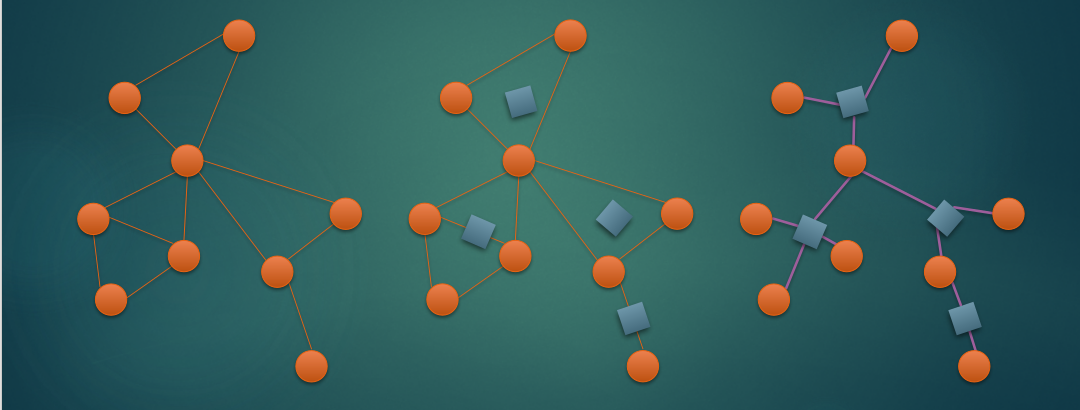仙人掌圓方樹學習筆記
阿新 • • 發佈:2019-01-09
以後會逐漸完善,現在會先存放一些程式碼
廣義圓方樹對於每個仙人掌的環新建一個方點,原仙人掌上的點為圓點,向這個環上的所有圓點連邊,使得所有的邊連線的都是 $ 1 $ 個圓點和 $ 1 $ 個方點
廣義圓方樹長這個樣子

然後就可以用樹形 dp 的方法來解決很多仙人掌上的問題啦
bzoj 4316(求仙人掌最大獨立集
建出圓方樹,進行樹形 dp
對於圓點 $ i $,記 $ f_{i,0} $ 表示不選取 i,i 子樹的最大獨立集,$ f_{i,1} $ 表示 $ i $ 子樹的最大獨立集
然後要注意一下在原仙人掌上有連邊的兩個點不能同時選
如一個方點的父親不能和它在原圖裡連的兩個圓點同時選
感覺這個 dp 也不是很煩
#include <bits/stdc++.h> #define CIOS ios::sync_with_stdio(false); #define rep(i, a, b) for(register int i = a; i <= b; i++) #define per(i, a, b) for(register int i = a; i >= b; i--) #define DEBUG(x) cerr << "DEBUG" << x << " >>> "; using namespace std; typedef unsigned long long ull; typedef long long ll; template <typename T> inline void read(T &f) { f = 0; T fu = 1; char c = getchar(); while (c < '0' || c > '9') { if (c == '-') fu = -1; c = getchar(); } while (c >= '0' && c <= '9') { f = (f << 3) + (f << 1) + (c & 15); c = getchar(); } f *= fu; } template <typename T> void print(T x) { if (x < 0) putchar('-'), x = -x; if (x < 10) putchar(x + 48); else print(x / 10), putchar(x % 10 + 48); } template <typename T> void print(T x, char t) { print(x); putchar(t); } const int N = 1e5 + 5; vector <int> a[N], b[N]; int low[N], dfn[N], f[N][2], tmp[N][2], st[N], top; int n, m, oldn, _time; void tarjan(int u) { st[++top] = u; low[u] = dfn[u] = ++_time; for(register int i = 0; i < a[u].size(); i++) { int v = a[u][i]; if(!dfn[v]) { tarjan(v); low[u] = min(low[u], low[v]); if(low[v] >= dfn[u]) { int tmp = 0; ++n; while(tmp != v) { tmp = st[top--]; b[n].push_back(tmp); b[tmp].push_back(n); } b[u].push_back(n); } } else low[u] = min(low[u], dfn[v]); } } void dfs(int u, int fa) { if(u <= oldn) { f[u][0] = 0; f[u][1] = 1; for(register int i = 0; i < b[u].size(); i++) { int v = b[u][i]; if(v == fa) continue; dfs(v, u); f[u][0] += f[v][1]; f[u][1] += f[v][0]; } f[u][1] = max(f[u][1], f[u][0]); } else { for(register int i = 0; i < b[u].size(); i++) dfs(b[u][i], u); tmp[0][0] = tmp[0][1] = f[b[u][0]][0]; for(register int i = 1; i < b[u].size(); i++) { int v = b[u][i]; tmp[i][0] = tmp[i - 1][1] + f[v][0]; tmp[i][1] = tmp[i - 1][0] + f[v][1]; tmp[i][1] = max(tmp[i][1], tmp[i][0]); } f[u][0] = tmp[b[u].size() - 1][0]; tmp[0][0] = f[b[u][0]][0]; tmp[0][1] = f[b[u][0]][1]; for(register int i = 1; i < b[u].size(); i++) { int v = b[u][i]; tmp[i][0] = tmp[i - 1][1] + f[v][0]; tmp[i][1] = tmp[i - 1][0] + f[v][1]; tmp[i][1] = max(tmp[i][1], tmp[i][0]); } f[u][1] = tmp[b[u].size() - 1][1]; } } int main() { read(n); read(m); oldn = n; for(register int i = 1; i <= m; i++) { int u, v; read(u); read(v); a[u].push_back(v); a[v].push_back(u); } tarjan(1); dfs(1, 0); print(f[1][1], '\n'); return 0; } // Rotate Flower Round.
